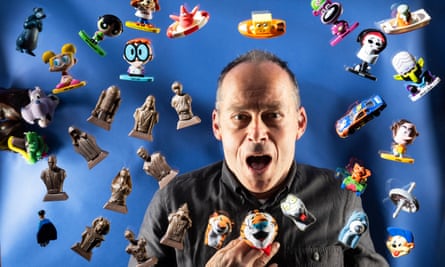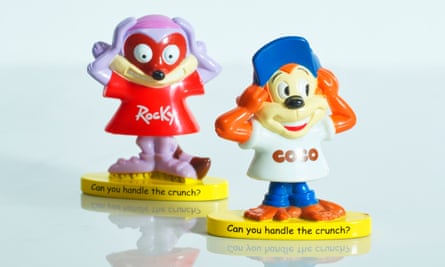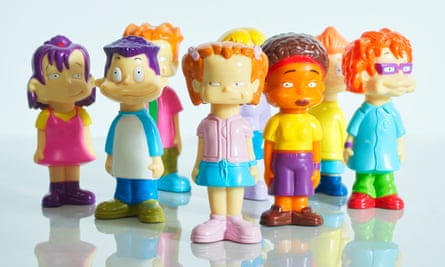[ad_1]
No one would ever guess, says product designer James Allerton, just how many people it took to make the glow-in-the-dark, lightsaber-shaped plastic puzzles once dropped by Kellogg’s into boxes of Corn Flakes.
Allerton, 47 from Sussex, now runs his own creative studio, but from 2000 to 2008 he worked for Logistix, a promotional marketing agency that founder Ian Madeley, 67, estimates manufactured more than 1bn cereal toys. Remember them? If you use Facebook, you could hardly forget them, as nostalgic memes regularly celebrate the baking powder submarines, Rugrats pencil toppers and Tony the Tiger-shaped bike reflectors that once plonked so satisfyingly into our bowls.
In mid-February, Shreddies and Cheerios manufacturer Nestlé warned of impending price hikes – last year, wheat shortages, shrinkflation and inflation had already increased the cost of breakfast. Yet, technically, when you buy a box of cereal today, you get less for your money than at any point in the past 60-odd years. “These days, the breakfast cereal aisle is bloody boring,” says Madeley. In the UK, cereal toys are no more. As a hopeless nostalgic, I have long wondered: where did these toys come from and where did they snap, crackle and pop off to?
In the 1975 sitcom The Good Life, protagonist Tom Good (Richard Briers) is a cereal-toy designer who packs it all in to become a self-sufficient suburban farmer. “It’s a mould for a plastic hippopotamus that’s going to end up in a packet of breakfast cereal,” he laments of his life’s work, while sitting in a drab office with dull colleagues, before quitting for good. In real life, however, cereal-toy designing was often great fun.
“We went on to film sets. We were flown out to LA,” says Allerton. Once, when designing Spider-Man water squirters, he was taken on a top-secret trip to Hollywood for a sneak peek at the upcoming film. Meanwhile, Madeley got to walk the red carpet London film premieres and stay at Lucasfilm’s Skywalker Ranch in San Francisco.

Marketer Nicola Rodrigues, 42, did the tougher work of liaising with licensors and ensuring that movie studios were happy with what ended up in the box. “They’re very strict and precious over how their characters appear,” she says, “My record, I think, was 16 rounds of amends on Spider-Man’s bottom.”
Allerton and Rodrigues say they can’t overstate the sheer number of experts involved in the process of making a cereal toy. Logistix was founded in Marlow in 1989 and first began designing toys for Kellogg’s in the early 90s. “We had a qualitative and quantitative research team, a dedicated quality-control team,” says Rodrigues. Madeley elaborates on the depth of their research. “We created various kid-tracking studies… We were collecting data on how much pocket money they got, how many kids had tellies in their rooms.”
By 1997, Simpsons-shaped rings that squirted water at unsuspecting victims were all the rage. In 2005, the team came up with Star Wars lightsabers that had “extended play value” thanks to a ball maze inside the toy.
Yet Logistix did not invent the concept of in-the-packet cereal toys. In 1957, Kellogg’s created miniature plastic submarines that could be filled with baking soda so they would sink and surface in the bathtub. That same year, “the amazing underwater frogman” was available in packs of Nabisco Shreddies. While the first ever free cereal promotion can be traced back to 1905 – when Quaker Oats offered real china bowls to customers who collected enough tokens – the 1950s were the first time that freebies were placed inside the box. From there, everything exploded. In 1966, you could get farm animals in your Sugar Puffs; in 1967 there were Noddy figurines among your Ricicles; in 1976 Mr Men stickers fell out of your Coco Pops box. By the time Logistix entered the arena in the 1990s, the cereal-toy industry was, Allerton says, “fiercely competitive”, thriving amid a licensing boom. Logistix was just one of three agencies that worked on promotions for Kellogg’s – each had to pitch their ideas.
“We were never guaranteed business,” Rodrigues says. Before pitching, Logistix would run focus groups with families, checking that designs were mum and child-approved. “They would say if they were rubbish. Kids are brutal,” Allerton recalls.
There were plenty of other challenges. Kellogg’s toys could be a maximum of 50 x 70 x 20mm. “You couldn’t stray even a few millimetres,” Allerton says. Each toy had to be above a certain weight so it would drop properly into the packet on the production line but, obviously, it couldn’t be too heavy. The toys were aimed at seven to eight-year-olds, but had to be suitable for all ages for safety reasons – they were checked in choking tester tubes. “You can’t have a flimsy arm that could be twisted and snapped off because a child could choke on it,” says Rodrigues.

“We were heavily restricted,” Madeley says. “So to produce something that might capture kids’ attention for a few minutes was quite challenging.” Each toy had to be made for around 6p (before wrapping costs) and most had to be gender-neutral with the occasional “slight boy bias” (after all, girls were happy to play with boys’ toys, but back then things rarely worked the other way round). Promotions would last anywhere between six weeks and three months. Some toys went out across Europe as well as the UK, which meant up to 80m units were made at a time in Asian factories. And the creative process often began two years before anything ended up in the box.
What, ultimately, was all this hard work for? Madeley explains that so-called “in-pack promotions” weren’t designed to get kids to eat more cereal, ploughing through box after box to collect a complete toy set. Instead, cereal toys were intended to create customer loyalty and “lock” consumers into one brand. Madeley also wants to bust another myth: “There was no conspiracy about holding some toys back,” he says. If there were six toys in one series, you had equal chances of getting any one of them. “There were no rare versions,” he says, “That’s all rubbish.”
Someone who appreciated all of this hard work is 57-year-old, Berkshire-based Nick Symes, a retired financial services manager who runs the YouTube channel, Cerealmad. Symes is unable to estimate exactly how many cereal toys he has in a collection he began in the 1970s, but he knows it’s “lots”.
“I just remember the joy you used to get when you’d see a brand new pack of cereal,” Symes says. “It seemed to be endless, until you got through to a new packet.” Around 30 years ago, Symes rediscovered his childhood cereal-toy collection in his parent’s loft and began searching in toy fairs and on eBay to complete his sets. He met another collector with a stall in Reading in the 90s, and from there connected with other hobbyists to sell and swap toys. Before the turn of the millennium, he started producing a newsletter for around 100 readers, The Cluck (the K was styled just like the one in Kellogg’s).
Eventually, Symes found it onerous to “eat all this bloody stuff, log it, collect it and write newsletters,” so he gave up. But in 2014, he started a website, cerealoffers.com. He is now unarguably the UK’s premier amateur cereal promotions historian; he has six crates full of vintage cereal packets – and once chatted with the son of a magician who produced magic trick toys for Shredded Wheat in the 1950s.
The most Symes has spent on a single item is £100 for a solid gold Weeto; the most he’s made is £400 when he sold a Doctor Who-branded cereal box. Symes is particularly fond of his Tom and Jerry, Sooty and Robin Hood toys, which stand proud in a cabinet in his study. He is sad that children today don’t get to experience the joy of cereal gifts: “I think they’re deprived.”
Why exactly did cereal toys disappear: was it environmental concerns, the financial crash, the fact that kids-these-days-mumble-grumble-mumble? Madeley says the end began in the mid-2000s, when consumer bodies started pressuring the government about healthy eating. “It was changes in legislation that killed it,” he says. The name Debra Shipley rattles in his head like a plastic figurine flung inside some frosted flakes. As a Labour MP in 2005, she pushed through the Children’s Food Bill, which circumscribed how food could be marketed to children.

“The theory was we were encouraging obesity, we were encouraging kids to eat more than they should be,” Madeley says, adding that cereal companies used to rely on Saturday morning TV to advertise toys to children, but increased scrutiny put a stop to that. Some companies weathered the storm – McDonald’s did not stop giving away Happy Meal toys – but cereal companies seemed warier of bad press. By 2007, you could get a free cyclometer with tokens cut from your Coco Pops pack.
While Britain bowed to political pressure, cereal toys are still available across the globe. Sydney-based agency Creata, one of Logistix’s competitors, was founded in 1978 and is still going strong. In 2022, they released Bowl Buddies – plastic cereal toy mascots that hang on the edge of your bowl – with Kellogg’s in North and Latin America. In 2017, Creata made DIY, Minion-themed number plates to be put inside boxes in Australia and New Zealand.
Still, bits of plastic don’t have the same pull that they used to. In the early 2000s, cereal companies started offering CD-Rom games in boxes, a sign of the changing times. Later, kids were directed to websites or apps where they could play branded games. Recently, QR codes on boxes of Shreddies sent customers to an augmented-reality game based on Avatar: The Way of Water.
Madeley sold Logistix to an American company in 2001; he left a few years later, right before it went bust. Allerton and Rodrigues still work together at the Cube Concept, a product design company that also creates toys. “We’re working very much in different materials these days,” says Allerton, “Lots of cardboard, wood, cork.”
In the past, Symes has collected stamps, coins and cards, but it’s his love of cereal toys and boxes that has now endured for more than 50 years. “I still don’t feel like I’ve ever grown up,” he says. “Just don’t get old too quickly, that’s my view.” His study is a shrine to his childhood – there’s a vintage Robin Hood poster on the wall as well as a framed original design of a Tom and Jerry branded fizzy-pop can. Then, of course, there are his neatly lined-up cereal toys – blobs of red, yellow, green, blue and pink that hold so many memories in just a few millimetres. “It’s nostalgia,” he says of his collection. “I love the thought of the innocence of youth, really.”
[ad_2]
Source link
